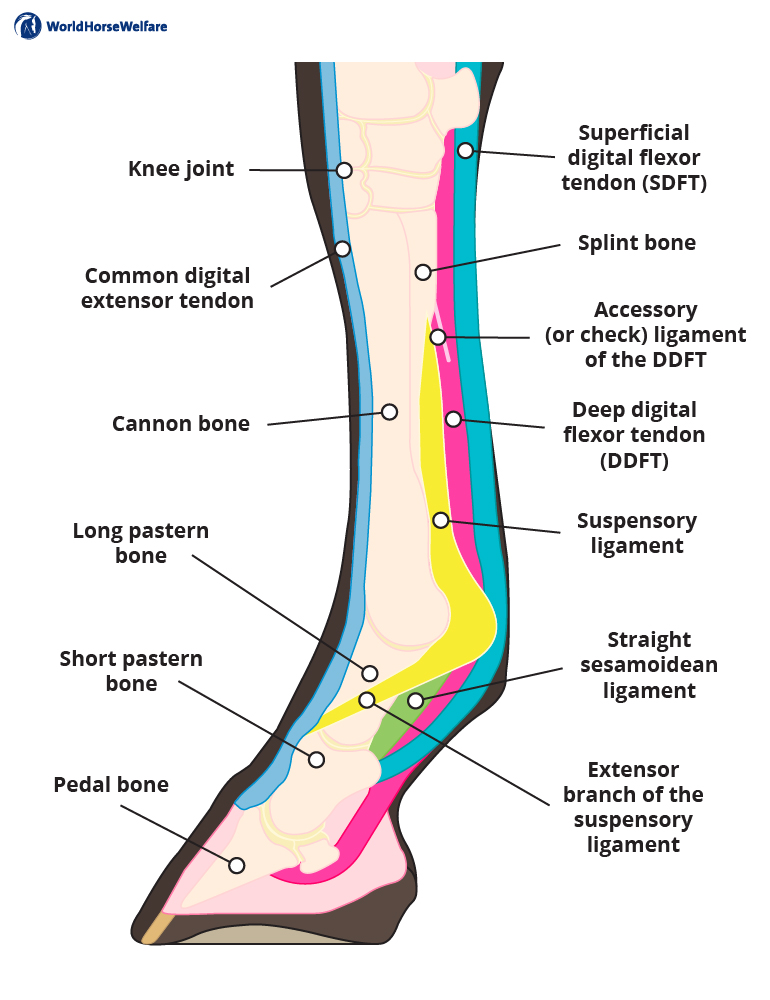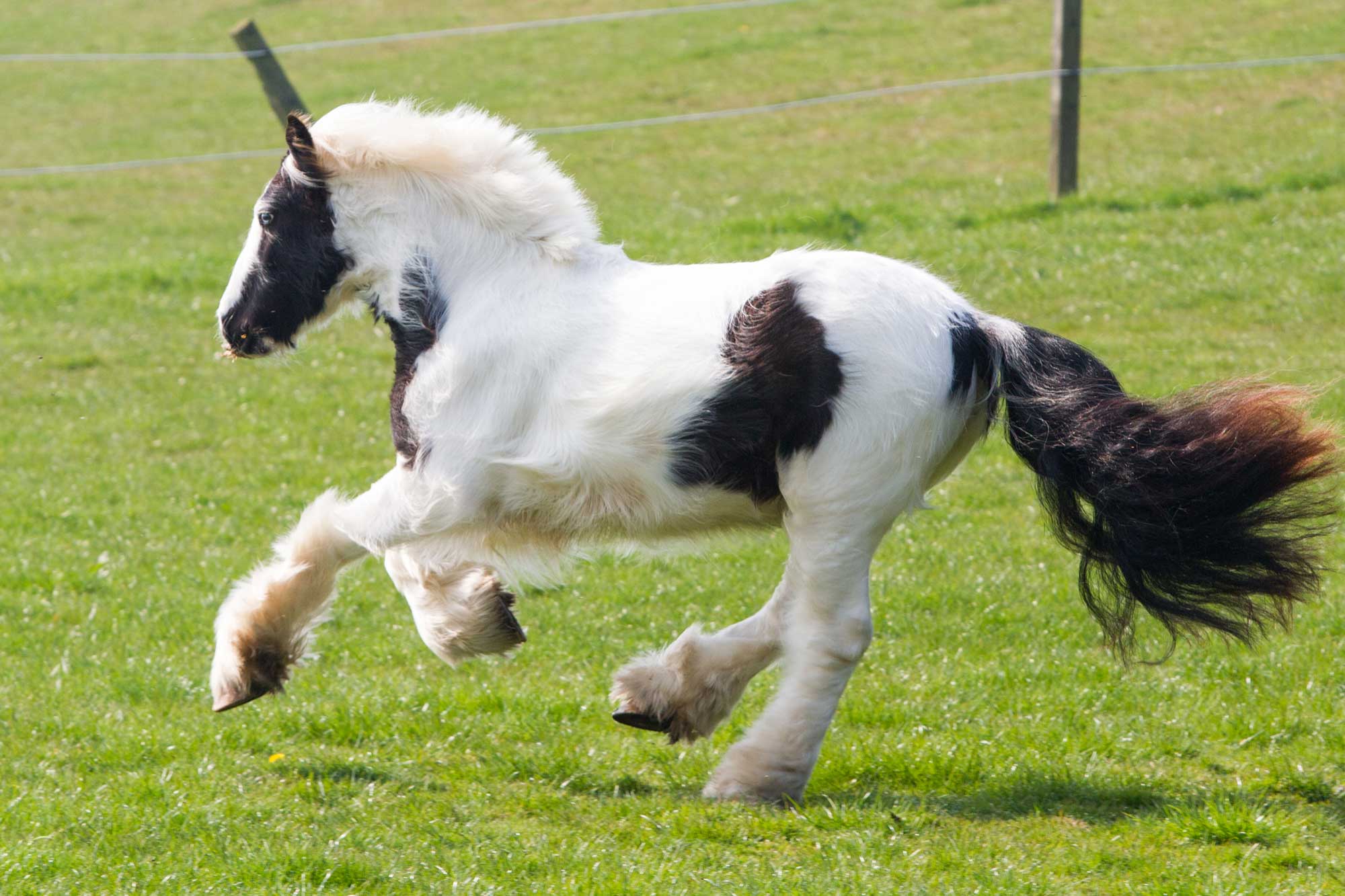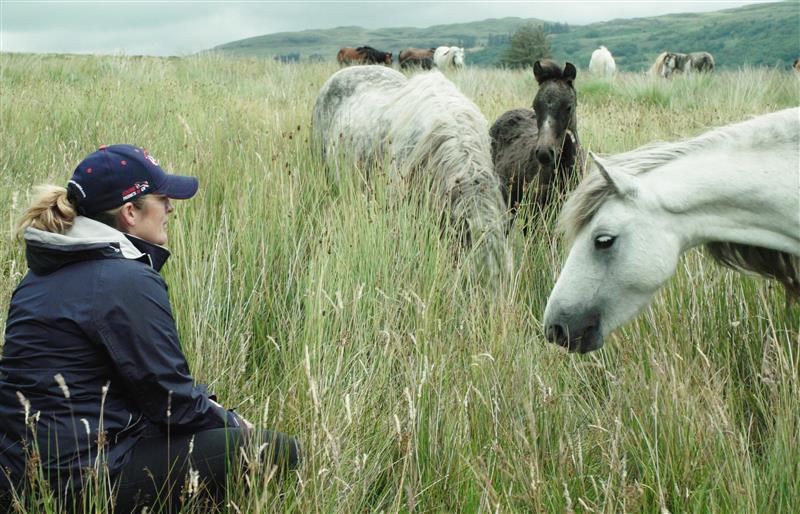The horse’s lower limb is a common site of injury. These injuries include wounds, such as cuts and lacerations, but also damage to soft tissues, including tendons and ligaments. You can find out more about cuts and other types of wounds on our Common horse wounds advice page. Many horses, whether ridden or unridden, sustain tendon or ligament injuries
Horses have no muscles in their legs below their knees and hocks – all the soft tissue structures in this part of the legs are:
- Tendons – which attach muscles to bones
- Ligaments – which attach bones to other bones.
Both tendons and ligaments are made of collagen, along with variable amounts of fibres with elastic-like properties.
The main job of tendons is to move one bone relative to another when a muscle contracts (shortens). In other words, when the muscle shortens, the ‘pull’ is transferred to the bone via the tendon and this makes the leg bend at a joint. Ligaments, in contrast, provide stability to joints by limiting the amount that each bone can move relative to the other. The suspensory ligament is not a typical ligament but can be injured in the same way as other ligaments and tendons.

Any tendon or ligament can be damaged by being over-stretched or by direct impact, and this can result in anything from minor tearing of fibres to complete rupture. Over-stretch can occur as one major episode or as repeated minor episodes where insufficient time is allowed for healing before it happens again.
Signs of tendon or ligament injuries:
- Lameness (degree of lameness will vary based on severity of injury)
- Heat and swelling in the limb e.g. “bowing” of a tendon
- Inflammation of a tendon sheath (this usually shows as excess fluid in the sheath, as in ‘tendinous windgalls’)
Diagnosis
Your horse should be assessed by a vet who will diagnose the injury and identify the structure(s) affected. As tendons and ligaments are soft tissues, diagnosis will typically involve ultrasound scanning rather than X-rays. However, both modalities can provide useful information that helps in understanding the full picture and it is sometimes helpful to use both methods. Ultrasound scans may be performed under light sedation to minimise how much the horse moves during the process, and to protect the vet and the scanner.
Treatment
Treatment will vary based on the severity of the injury, but can include:
- Box rest (if your horse lives out, discuss alternative options with your vet)
- Pain relief and anti-inflammatory medication
- Cold hosing
- Supportive bandaging
- Corrective/therapeutic shoeing
- Controlled exercise
- Therapeutic treatments such as:
- Ultrasound therapy (short wavelength sound)
- Laser therapy (coherent red or infrared light)
- Stem cells (cells from the horse’s body which have the potential to turn into any type of cell/tissue type)
- Platelet-rich plasma (a substance drawn from the horse’s blood which is rich in growth factors)
- Extracorporeal shock wave therapy (short, high intensity pulses of short wavelength sound)
There is little good evidence to support the use of a number of therapies that may be recommended for the treatment of tendon and ligament injuries, some of which are very expensive, and it is wise to ask your vet about the documented success rate of any treatment that may be proposed.
Rehabilitation
When tendon and ligament injuries heal, it is by formation of scar tissue within the healthier parts of the affected structure. This scar tissue is not as robust as the original tissue and is prone to reinjury. Rehabilitation needs to be undertaken slowly and patiently in a step-wise fashion – this is the only way that you will achieve the best possible outcome and minimise the risk of reinjury once work recommences. The rehabilitation programme for each horse with a tendon or ligament injury will depend on the severity of the injury plus their ability to cope with potentially stressful situations, such as box rest.
It is important to follow your vet’s guidance and to introduce work gradually, starting with walks in hand and progressing slowly up to ridden work, gradually improving your horse’s fitness. Throughout the rehabilitation process, it is important to monitor the area closely and potentially schedule follow-up scans with your vet to check how the injured area is healing in the face of the increasing work. It is also worth working with a veterinary physiotherapist who can recommend suitable strengthening exercises and ways to keep your horse strong and supple, even when on box rest e.g., carrot stretches.
Other common rehabilitation exercises (that should only be undertaken with agreement from your vet) include:
- Walking over ground poles/raised poles
- Use of water treadmills
- Long-reining
Minimising the risk of injury
Hoof care
Hoof balance can influence the risk of tendon and ligament injuries. For example, a long toe and low heel will increase the risk of deep digital flexor tendon (DDFT) injury, and poor side-to-side balance can increase the risk of damaging the ligaments that stabilise the coffin joint in the horse’s hoof (collateral ligaments). The risk increases if horses don’t receive regular hoof trimming and, if required, appropriate shoeing.
Cross-training and workload
Horses that are turned out on varied terrain and, if ridden, are cross-trained on a variety of surfaces are less likely to suffer from tendon/ligament injuries. By implementing a structured exercise and training programme, you can target specific areas of the horse’s body and work on incrementally increasing strength and fitness. Varying your horse’s workload to include light work and rest days will give any tendons or ligaments that have suffered minor damage time to repair. Try not to push your horse too far beyond their limit: improving fitness through exercise does require some stress but any increases need to be gradual. For example, it would be unfair to take a horse usually used for light hacking out for a day’s cross-country schooling, as they would not be fit enough to do so, and this could lead to injury.
Boots and bandages
If you choose to ride your horse wearing boots or bandages, assess whether the horse really needs them. A well-designed boot, or a good bandage, will provide some protection from a knock or a strike from another limb, but no boot/bandage will protect a tendon or ligament from strain (over-stretch). In addition, it has been shown that horses’ legs – and therefore the tendons – can get very hot when wearing boots and/or bandages, and this predisposes to injury. There is currently little to no evidence to support the use of many boots, wraps and bandages that are currently on the market, so we encourage you to shop wisely.
Popular advice in Health

Mites: how to treat them in horses
Find out how our experienced teams tackle this itchy problem in affected horses and ponies.
Other advice categories
All webinar categories:
Call our Advice Line
+44 (0)1953 497 238Not found the advice or answer you were looking for here? Then our Advice Line is available during office hours, or you can email us on [email protected] to let us know what topics you were looking for.



